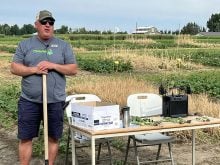A variety of organizations have developed programs that allow producers to learn more about taking care of their soil
MINNEAPOLIS, Minn. — Jay Watson understands that farmers listen to other farmers.
So, if food companies and agri-food corporations want producers to try new practices and shift toward regenerative agriculture, it will require peer to peer education.
“Without that, we’re going to have a hard time reaching scale,” said Watson, while on stage at the Reuters Transform Food & Ag conference held in Minneapolis in October.
Read Also

August rain welcome, but offered limited relief
Increased precipitation in August aids farmers prior to harvest in southern prairies of Canada.
The scale in his comment refers to government and corporate goals of making regenerative agriculture a standard practice on thousands of farms and millions of acres.
Some in the agri-food industry believe payments or financial incentives will convince farmers to try cover crops or reduced tillage, but Watson and General Mills are honing in on grower education.
“Some (of our) programs don’t even have those financial elements. It’s more focused on training and technical assistance … community and culture building,” Watson said.
“The producer has to know how to be successful in implementing something new …. We (General Mills) are thinking about how we make sure those dollars we employ are well spent and drive lasting change.”
In Canada, General Mills has partnered with ALUS on a regenerative agriculture program called Growing Roots.
ALUS partners with farmers to create “nature-based solutions on their land” that are designed to improve climate resilience and biodiversity.
From 2022-24, ALUS enrolled 115 western Canadian producers in the Growing Roots program. They are involved in 234 regenerative agriculture projects across more than 12,000 acres, ALUS said in a July 2024 press release.
General Mills is committed to Growing Roots and is providing more funding, which will extend the program through 2026.
At the heart of the project is training and peer to peer education. ALUS has created a partnership advisory committee of farmers, agronomists and other leaders in regenerative agriculture.
Those experts share their knowledge with producers in the program.
“Farmers look to each other to find guidance and support, and ALUS helps create the community needed for this …. (This program) allows me to provide that support by sharing the successes and failures my operation has experienced with a larger network of producers,” says Tannis Axten, who runs Axten Farms in Minton, Sask.
Other organizations also use training to spread the good word about soil health.
Starting this year, Assiniboine Community College in Brandon will deliver training to certified crop advisers in Manitoba and Saskatchewan about soil health and conservation agriculture. The program is branded as the Canadian Prairies Trusted Advisor Partnership.
General Mills, PepsiCo, Bimbo Canada, Nature United and the SouthEast Research Farm in Redvers, Sask., support the program.
“It will offer a master class in soil health agronomy, water management and diversified cropping systems, covering established and emerging stewardship practices in topics like residue management, zone mapping, variable rate technology and tillage reduction,” says a news release from last August.
In a related project, the college is developing a soil health network with support from the Weston Family Foundation. It has created a website, www.soilhealthnetwork.ca, to share information and create a peer to peer network.
It’s clear from the ALUS and General Mills project that farmers want to improve the health of their soils.
A survey asked the 115 farmers in Growing Roots about their reasons for joining the program.
Ninety per cent said they want to build soil health and more than 80 percent said they want to improve soil organic matter. About 70 per cent said they want to enhance soil water infiltration.
Less than 10 per cent were interested in markets for regenerative commodities and only 20 per cent were motivated by potential payments from carbon markets.
















